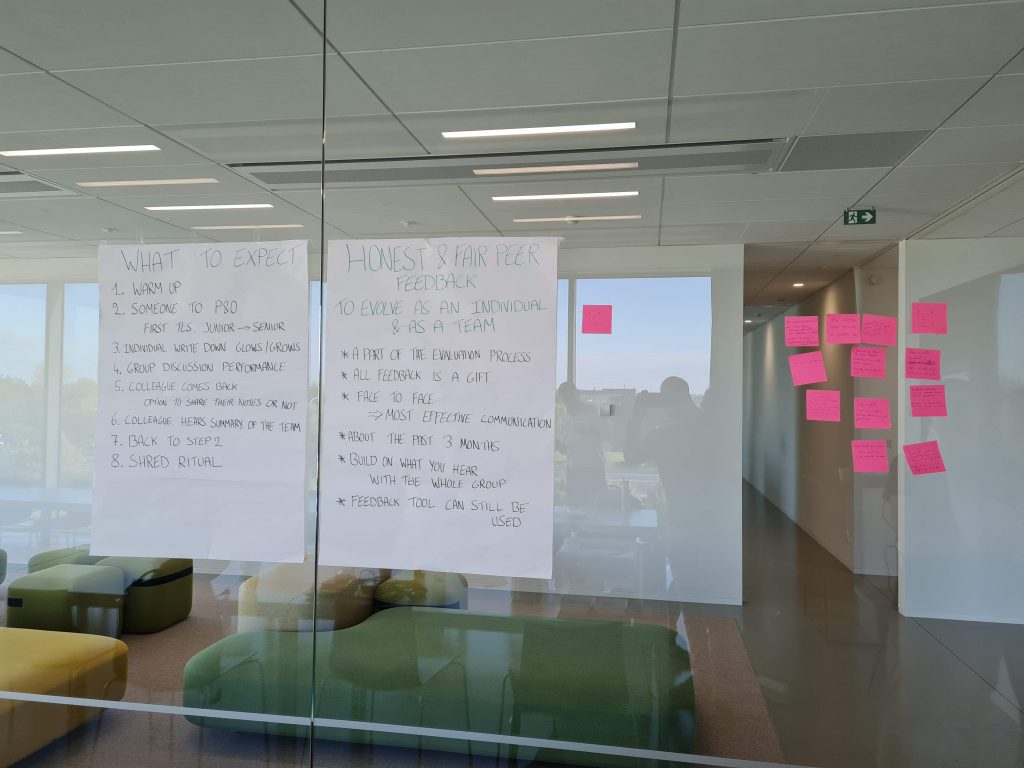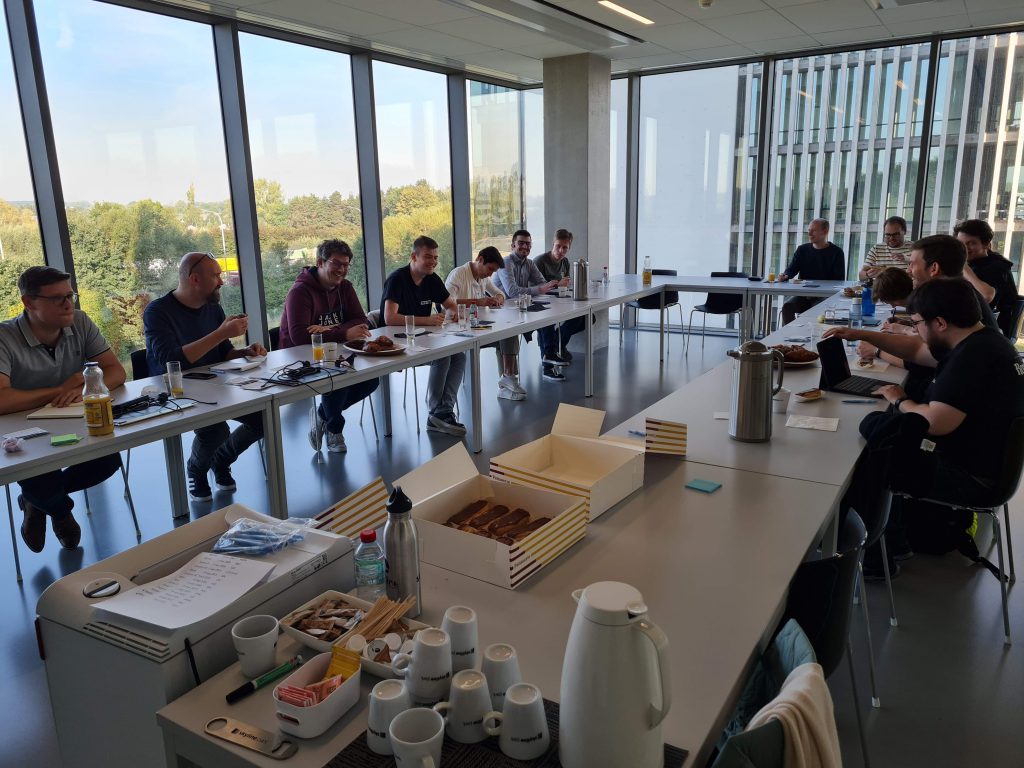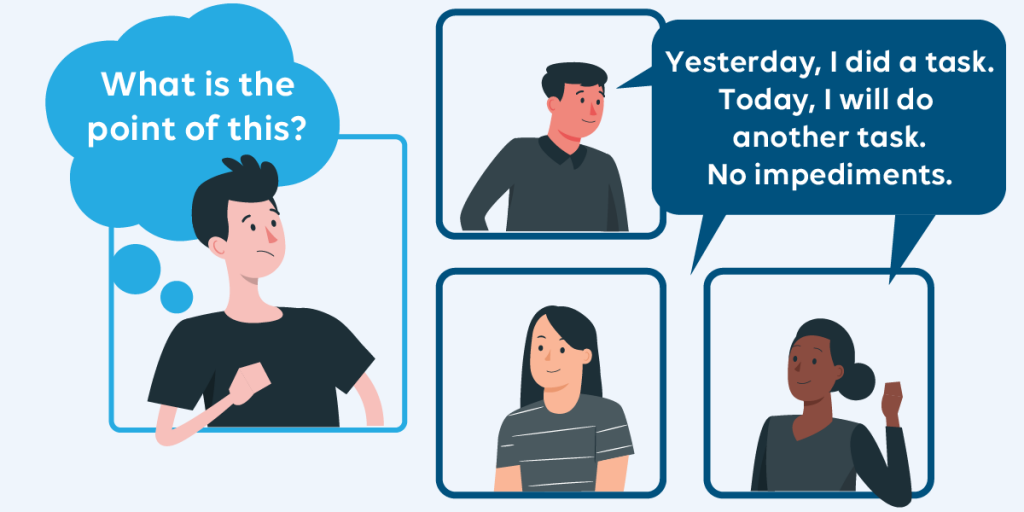Peer feedback is an essential component in evolving as a person, a team, and an organization. Additionally, it’s also an undeniably important and great evaluation tool.

As a company, Skyline is constantly looking for new and better ways to handle peer feedback. Employees now get multiple options. This to make giving feedback as valuable and comfortable as possible for both the team and their managers.
In this post, we share some ideas on different kinds of peer feedback. In doing so, we hope to give you some inspiration for your own environment.
End-of-year peer review
The first system that was made available is an online tool through which you can evaluate your peers. This requires you to describe how that person performed in the different aspects that are valued by the company: job knowledge, work approach, ownership, coaching, stakeholder management, and career aspirations. Certain expectations are linked to each of these aspects. These vary, depending on the current “level” you have at Skyline. Based on these expectations, you give a rating ranging from “not in line with expectations” to “exceeds expectations”, and you motivate your choice.
This is done once a year for the people in your direct vicinity. In combination with other factors, the manager takes this into consideration and uses it to evaluate everyone. Before the compensation statement, you can have a talk with your manager about the feedback you received and will hopefully learn from it.
Pros
- Clear expectations to be met by corporate
- Rating system gives an indication of how well you perform overall
- Clear link to what you earn
- All feedback you receive is a gift
Cons
- Little room for own interpretation of requirements
- No room to improve before compensation statement
- Not face to face
- Everyone’s opinion is valued equally (working more closely with someone doesn’t matter)
- A lot of time in between annual commits

Continuous feedback
Since introducing the end-of-year feedback, the online tool has gone through an evolution, leading us to a new way of evaluating. The end-of-year review was linked predominantly to the evaluation, while the aim was to also give people valuable feedback to work on and to improve themselves. The quicker you get feedback, the faster you can improve. Therefore, continuous feedback was introduced.
The old system remains in place, but within the same tool, there is now an option to give some quick feedback based on an experience you had with a specific person. No more different job aspects to consider, no more company expectations to link to, not even a need to consider the rating. Just write your thoughts down in a comment box, choose “continuous” in the drop-down list, and directly communicate your findings to your colleague and have it documented for the eventual evaluation simultaneously.
Now, the colleague has time to take the feedback to heart and improve on it immediately, leading to a better and more accurate evaluation each year. Because, after all, being able to adapt and improve over time is a great quality to have as well!

Pros
- Quick, continuous feedback allows quick learning
- Takes up small bits of your time at once
- All feedback you receive is a gift
Cons
- Not face to face
- Requires a certain amount of trust in management to correctly interpret (older) feedback and its weight
Big room feedback
The 2 main cons, prevalent with continuous feedback, are what pushed Skyline to try out a completely different kind of peer feedback environment. Face-to-face communication is the best form of communication. This is a thing everyone, from developers to business leaders, can agree on. Involving management directly helps mitigate the above mentioned possible lack of trust in their interpretation of written feedback. Therefore, we started working on a way to incorporate the face-to-face aspect in our feedback. Introducing the big room feedback.
Three times per year, the entire team gathers physically, along with management, HR, and some neutral people to lead the meeting. The goal: high-performing teams. For that, we need fair and honest peer feedback.
You can find a full outline of how the big room feedback is organized below. Credits to Marc Vandyck from Agile Atelier for sparking the idea.
Purpose and framework
At the very start of the session, the purpose and framework of the session are explained by the moderator.
- Purpose: High-performing teams, for which we need fair and honest peer feedback.
- This is NOT the performance evaluation. Your direct managers still oversee the eventual evaluation.
- All feedback is a gift. Remember again, this is not an evaluation. The amount of positives and negatives you hear is not directly indicative of how well you are performing.
- Face-to-face is the most effective type of communication.
- Feedback relates to e.g. the past four months (or however often you give feedback).
- Some individual time, but most of all, it is a group discussion.
Confirm if the purpose is understood and if there are any questions before continuing.

Outline and flow
When the purpose is clear, the flow of the session is explained.
- Warm-up
For a couple of minutes, the team brainstorms on things that happened in the last 4 months. This can range from big goals that the team worked on, to new people that joined, to a team-building activity you did. The key words are written on a whiteboard and serve as inspiration for the rest of the session. - Colleague steps outside
The next person in line leaves the room to have a talk with HR. Here you can discuss what you consider being your grows and glows, score your happiness at the company, etc.
The managers in the meeting go first, followed by team members, from junior to senior, in order of years of experience at the company. The intent here is that new topics keep coming up throughout the day. - Writing grows & glows (3 min)
While a person has left the room, everyone gets 2 to 3 minutes to write down what they consider to be grows and glows for that person.
> A glow is something that makes that person glow, something they excel at.
> A grow is something that person has room to grow at, things to improve.
A star system allows you to give weight to your opinion. If you feel strongly about something (e.g. because it’s important or because you work closely together with that person) you can give your grow/glow more stars.
Don’t get too hung up on what you write down on a piece of paper. An item can be both a grow and glow at the same time, the important things will be discussed, etc. Nuance will be added during the group discussion.
Write only one grow/glow per piece of paper. That makes it easier for the secretary to sort and consolidate the feedback. - Group discussion – THE MAIN EVENT (7 min)
The impartial secretary and moderator gather all the grows and glows. The remarks that pop up the most and have the most amount of stars are discussed first. It’s likely not possible to discuss all glows and grows in this one discussion, but that’s okay. A person should focus on their most important glows and grows anyway and should try to improve (or persist with) these first.
The neutral moderator leads the discussion, trying to gather everyone’s opinion on the topic to make sure there are no misunderstandings. The secretary writes a summary on a person’s grows and glows, based on this discussion.
The grows/glows are merely a trigger to get the discussion going. The group is allowed and even encouraged to change topics mid discussion as long as it’s about performance feedback for the person that stepped out of the room. - Colleague shares
After the group discussion, the moderator brings back the two people that had previously left the room (HR and the colleague that was just discussed). The colleague then gets the chance to share their own perceived grows and glows. The moderator makes notes on this in the summary so that it can be incorporated in the next step. - Colleague hears summary
The moderator reads the summary out loud in front of the entire group. This way, we are certain the correct message gets across. Afterward, the colleague receives the summary as well. - Repeat
We now move on to the next person in line and return to step 2. Repeat until the entire group has had their turn. - Shredding ritual
At the end of the entire session, all grows and glows are collected and everyone gets to throw their pile in the shredder. Of course, you can also burn them if you prefer a little bonfire.
Some practicalities
During the entire session, no one can use a laptop to make notes. Tribe leadership and the Agile Coach of the team can use a notepad. Tribe leadership will take notes for their evaluation based on all the grows and glows, and the team discussion. The Agile Coach might take some notes here and there for further clarification or follow up after the session.

Pros
- Potentially good for team spirit, being able to be open with each other
- All feedback you receive is a gift
- Face-to-face still is the most efficient and effective way of communication
- Possible to clarify what’s meant. Contextualize. There are fewer misunderstandings.
- You can collaborate and soundboard with everyone present
- No administration
- On average takes less time overall
Cons
- Fear it could be bad for team spirit
- The opinion of “louder” people might weigh more. (Should be partially countered by the facilitator and the individual time to write down grow/glow)
- Reluctance to give honest feedback face to face
- Less time to think things through
You might also like

BLOG
Do you have to answer “the three questions” during every Daily Scrum?
Learn how you can achieve the purpose of a Daily Scrum without utilizing the “three questions”.

BLOG
Best practices to order your product backlog
Take a look at some common practices to order your product backlog. Ranging from manual ordering to formulas, to aspects worthwhile to consider.
Great insights. Thank you!